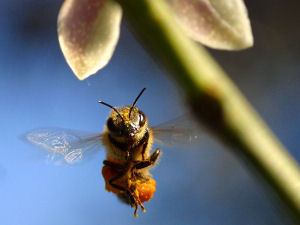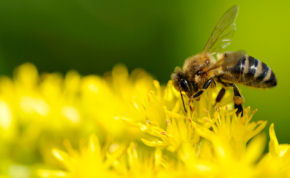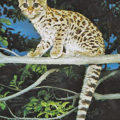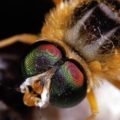
Honeybees can discriminate between patterns containing two and three dots – without having to count the dots, a research team reports in the journal PLoS ONE. And, with a bit of training, the bees can learn to tell the difference between three and four dots. However at four, bee maths seems to run out.
The researchers, led by Dr. Shaowu Zhang, Chief Investigator of The Vision Centre and Australian National University and Professor Hans Gross and Professor Juergen Tautz of Wurzburg University in Germany, observed the bees flying through an entry of a Y-maze marked with a pattern of either two or three dots, which were signposts to a reward. The bees then had to choose between two patterns by correctly matching the number of dots, to find where the reward was – a feat they then managed to repeat reliably once they had learned that two dots at the first entry meant they had to look for two dots at one of the second pair of patterns, where the reward was hidden.
Presenting blue and yellow dots, stars and lemons, or random patterns didn’t fool the insects, which continued to reliably navigate their way to the reward once they had figured out and memorized what the signs meant, based on number. To begin with, the bees spent quite a bit of time scanning the dots. On later visits they zipped straight past them, once they knew what they meant.
“Bees can definitely recognize the difference between two, three and four – although four a little less reliably. This is a process known as ‘subitizing’ – which means responding rapidly to a small number of items. “We think the bees are using two memory systems,” Dr. Zhang says. “First is working memory, which they use to recall the number of dots that point to the reward. The second system is to use memory rules. We found this out by changing the pattern of the dots – but the bees still managed to locate the reward.”
The experiment also demonstrates the remarkable learning power of social insects, which have to go out foraging over long distances and then find their back to the hive, and out to the food source again reliably. Dr. Zhang says the ability to discriminate between different numbers is part of this navigation, perhaps as bees pass clumps of two trees or three trees on their way to the food source, or use similar patterns among flowers or other landmarks as they draw close to it.
“There has been a lot of evidence that vertebrates, such as pigeons, dolphins or monkeys, have some numerical competence – but we never expected to find such abilities in insects. Our feeling now is that – so far as these very basic skills go – there is probably no boundary between insects, animals and us,” he concluded.
Related:
Two Bees? Aw, Not Two Bees…
“Shocking” Pesticide Levels Found In Beehives
Cell Phones To Blame For Deserted Bee Colonies?








Comments are closed.